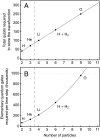Polynomial-time quantum algorithm for the simulation of chemical dynamics
- PMID: 19033207
- PMCID: PMC2596249
- DOI: 10.1073/pnas.0808245105
Polynomial-time quantum algorithm for the simulation of chemical dynamics
Abstract
The computational cost of exact methods for quantum simulation using classical computers grows exponentially with system size. As a consequence, these techniques can be applied only to small systems. By contrast, we demonstrate that quantum computers could exactly simulate chemical reactions in polynomial time. Our algorithm uses the split-operator approach and explicitly simulates all electron-nuclear and interelectronic interactions in quadratic time. Surprisingly, this treatment is not only more accurate than the Born-Oppenheimer approximation but faster and more efficient as well, for all reactions with more than about four atoms. This is the case even though the entire electronic wave function is propagated on a grid with appropriately short time steps. Although the preparation and measurement of arbitrary states on a quantum computer is inefficient, here we demonstrate how to prepare states of chemical interest efficiently. We also show how to efficiently obtain chemically relevant observables, such as state-to-state transition probabilities and thermal reaction rates. Quantum computers using these techniques could outperform current classical computers with 100 qubits.
Conflict of interest statement
The authors declare no conflict of interest.
Figures



References
-
- Manthe U, Meyer H-D, Cederbaum LS. Wave-packet dynamics within the multiconfiguration hartree framework: General aspects and application to NOCl. J Chem Phys. 1992;97:3199–3213.
-
- Wu YH, Batista VS. Matching-pursuit for simulations of quantum processes. J Chem Phys. 2003;118:6720–6724.
-
- Ben-Nun M, Martinez TJ. Nonadiabatic molecular dynamics: Validation of the multiple spawning method for a multidimensional problem. J Chem Phys. 1998;108:7244–7257.
-
- Wu T, Werner H-J, Manthe U. First-principles theory for the H + CH4 → H2 + CH3 reaction. Science. 2004;306:2227–2229. - PubMed
-
- Wang H. Basis set approach to the quantum dissipative dynamics: Application of the multiconfiguration time-dependent Hartree method to the spin-boson problem. J Chem Phys. 2000;113:9948–9956.
Publication types
MeSH terms
LinkOut - more resources
Full Text Sources
Other Literature Sources
Research Materials

